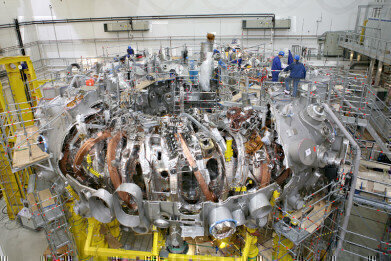News & Views
Introducing the World's Largest Stellerator - Wendelstein 7-X
Nov 11 2015
It’s no secret that the Germans love to be at the cutting edge of new developments. Now, a ‘Deutsh’ research team has proven this theory true by successfully completing the construction of a next generation experimental fusion reactor. According to the team the device will be capable of supporting the longest sustained reaction known to man!
So what exactly is a nuclear fusion reactor?
The machines actively replicate the processes that occur inside stars to create electricity. This involves fusing lighter atoms such as hydrogen or helium together in order to create heavier elements. Nuclear fusion is a relatively new arena and is still in its experimental stages. At present, scientists are unable to recreate the extremely hot atoms (blazing at over 100 million kelvins) that are required to facilitate the process. That said, exciting new developments are on the horizon which means that the world could see the introduction of commercial power stations in as little as 25 years.
German precision strikes again
Max Planck, a scientist at the Institute for Plasma Physics in Germany is pioneering the development of experimental fusion reactors that could be used on a large scale. To create the scorching hot plasma Planck and his team have created a new machine called Wendelstein 7-X (W7X). The device measures in at 16 metres in diameter which makes it the largest stellarator on the planet.
First invented by American physicist Lyman Spitzer back in 1950, stellarators force plasma into a twisted donut form using magnetic fields. This sustains a controlled nuclear fusion reaction that simulates the process occurring inside stars. Planck and his team hope that their modernised design will be suitable for use with commercial fusion reactor technology.
The German built reactor cost over £715 million to build and was 19 years in the making. In total it has a huge 425 metric tons of superconducting magnets, as well as 250 ports to supply and remove fuel. Unsurprisingly advanced 3D technology was the only way to fashion such a forward thinking machine, with Thomas Klinger, leader of the project confirming that “It can only be done on computer.”
Educational institutions are pivotal to the scientific world. ‘Putting NMR in the Hands of the Undergraduate Chemistry Student’ celebrates the achievements of the University of Melbourne’s School of Chemistry and its support of undergraduate teaching through the investment of a Spinsolve benchtop NMR spectrometer from Magritek system. It’s allowed the university to offer the chemists of tomorrow hands on practical sessions involving modern instrumentation that facilitates meaningful and relevant research.
Image via Flickr Creative Commons. Credits: Wikimedia
Digital Edition
Lab Asia 31.2 April 2024
April 2024
In This Edition Chromatography Articles - Approaches to troubleshooting an SPE method for the analysis of oligonucleotides (pt i) - High-precision liquid flow processes demand full fluidic c...
View all digital editions
Events
Apr 28 2024 Montreal, Quebec, Canada
May 05 2024 Seville, Spain
InformEx Zone at CPhl North America
May 07 2024 Pennsylvania, PA, USA
May 14 2024 Oklahoma City, OK, USA
May 15 2024 Birmingham, UK


















